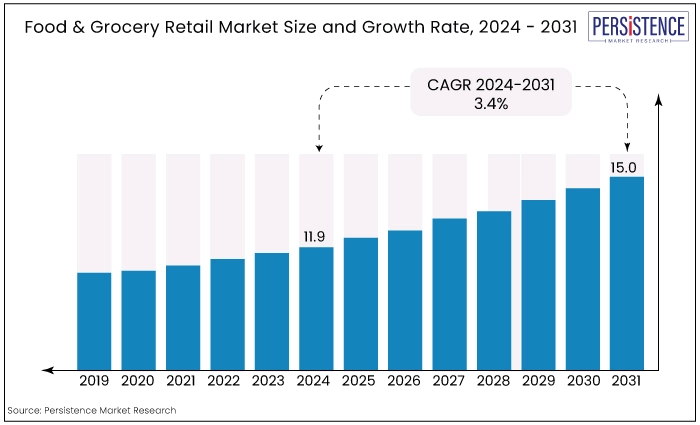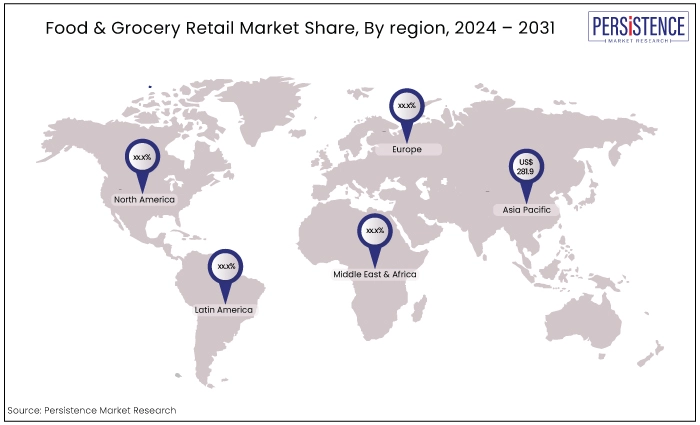Industry: Food and Beverages
Format: PPT*, PDF, EXCEL
Delivery Timelines: Contact Sales
Report Type: Ongoing
Report ID: PMRREP34622
The market was estimated at US$11.9 Tn in 2024 and is expected to be valued at US$15.0 Tn by 2031. The market for food & grocery retail is expected to reach an increasing CAGR of 3.4% from 2024 to 2031.
Key Highlights of the Market
|
Food & Grocery Retail Market |
|
|
Market Value (2031F) |
US$ 15.0 Trillion |
|
Global Market Growth Rate (CAGR 2024 to 2031) |
3.4% |
|
Historical Market Growth Rate (CAGR 2019 to 2023) |
2.7% |
The food & grocery retail market analysis shows a significant growth in recent years. It is a crucial sector that caters to the daily needs of consumers. It encompasses a wide range of products, including fresh produce, packaged goods, beverages, and household items.
With the rising global population and increasing urbanization, the demand for food and grocery retail is expected to witness significant growth in the coming years.
The market is expected to US$15.0 Tn till the end of 2031. This growth is attributed to several factors. There experiencing a rapid shift towards e-commerce and digital platforms.
With the increasing penetration of smartphones and internet connectivity, consumers are increasingly opting for online shopping convenience. This trend is fueling the market expansion
Increasing health-consciousness and varied healthier food options is another trend that is driving the demand for organic, natural, and functional foods. This encourages retailers to adopt sustainable and ethical practices.
Further, increasing environmental concerns are prompting consumers to seek environmentally friendly options in the food and grocery retail indusry, which is expected to drive the industry.

The market has witnessed significant growth in recent years. According to the Census Bureau, food and beverage store sales in the United States experienced a year-over-year increase of 7.6% in 2022, amounting to $947.57 billion.
From January 2020 to May 2020, UK supermarkets' grocery sales spiked by 63% compared to 2019. The growth can be primarily attributed to the COVID-19 lockdown-induced higher spending on groceries, increased online grocery sales volume, and consumer preferences.
The global food & grocery retail market size was valued at US$ 11.9 trillion in 2024 and US$ 15.0 trillion by 2031 to grow at a compound annual growth rate (CAGR) of 3.4% from 2024 to 2031. The trend of online shopping and restocking of food and grocery items during the COVID-19 lockdown increased revenues.
Further, ready-to-eat and simple-to-prepare food products are gaining popularity due to their convenience. Online grocery shopping is another convenient way of fueling food and grocery sales.
The availability of a variety of food and groceries and a focus on health and fitness create a need for healthier eating options, which is further driving the market growth.
Increased Online Grocery Sales Volume
The COVID-19 pandemic has accelerated the growth of online grocery shopping. Consumers turned to online channels to fulfill their grocery needs during lockdowns and social distancing measures.
Online sales are projected to account for 17.2% of the total grocery market in 2024. This shift towards online platforms has contributed to the market expansion.
Consumer Polarization and Higher Spending on Groceries
The pandemic-induced lockdowns and increased cooking at home have led to higher spending on groceries. Some consumers scaled up their purchases, opting for more expensive products.
Along with the increased focus on cooking at home, the emergence of consumer polarization has been a major growth driver for the market.
Shifting Consumption Interest to Food Retail
The COVID-19 pandemic has significantly impacted the food service industry, leading to a shift in consumer spending from food service to food retail.
With restrictions on dining out and increased safety concerns, consumers have turned to grocery stores for their food needs. This shift in consumption expenditure has contributed to the growth of the food and grocery retail industry.
Cost and Affordability
Price is a significant factor in consumer purchasing decisions in the food and grocery retail market. New entrants must strike a balance between affordability and profitability.
The presence of established brands and private-label products from retailers can create pricing pressures for new players. Managing costs while offering competitive prices can be a challenge for businesses entering the market.
Distribution and Supply Chain Management
Effective distribution and supply chain management are crucial for success in the food & grocery retail market sales. Manufacturers and suppliers need to ensure a reliable and efficient supply of products to meet consumer demand.
Challenges such as logistics, inventory management, and maintaining product freshness can impede the entry and growth of new players in the market.
Online Grocery Growth
The online grocery platforms are expected to continue their rapid growth. Online sales are projected to account for 17.2% of the total grocery market by 2024, showing a substantial increase from previous years.
With evolving customer expectations, increased competition, and technological advancements, online grocery could account for a significant share of the food-at-home market.
In leading European countries, online grocery is projected to make up 18 to 30% of the food-at-home market by 2030. On the other hand, By 2025, the share of online grocery sales in the US market is expected to exceed 10%, indicating significant growth potential.
Technological Advancements
Technology plays a crucial role in the future of the food and grocery retail sector. Artificial intelligence (AI) algorithms are being utilized to optimize inventory management, reduce food waste, enhance demand forecasting, and improve customer service. AI-based analysis can provide actionable insights and help retailers make data-driven decisions.
Sustainability and Ethical Practices
Consumers are increasingly concerned about sustainability and ethical practices in the food and grocery retail industry. Retailers that prioritize sustainable sourcing, reduce food waste, and adopt eco-friendly packaging will have a competitive advantage.
Partnering with local suppliers and focusing on responsible supply chain management can also resonate with environmentally conscious consumers.
|
Category |
Market Shares in 2031 |
|
Fresh Food |
3.0% |
|
Hypermarkets and Supermarkets |
2.8% |
Fresh Food is Defining an Excellence in the Products Segment
Based on products, the fresh food segment is projected to maintain a CAGR of 3% by 2031. Its lasting appeal stems from its ability to provide consumers with access to unprocessed, wholesome produce, meeting the increasing demand for healthier dietary options.
As consumers continue to prioritize nutrition and freshness in their culinary endeavors, the fresh food segment remains a crucial component of the market. Its growth is sustained by a diverse range of high-quality offerings and the ever-evolving preferences of consumers.
Packed Food is Setting New Standards for Category Segment in the Market
By category, the market is divided into packed and unpacked products. The packed segment dominates the market with its significant shares. Retailers prefer to stock packed grocery items as they have a longer shelf life, enabling better inventory management.
Packed food items also offer convenience to consumers as they save time and effort in cooking. This drives revenues from the packed food segment, which is expected to witness continuous growth in the coming years.
Hypermarkets and Supermarkets Becoming New Ground for Higher Market Sales
Based on distribution channels, the global food and grocery retail market is segmented into hypermarkets and supermarkets, convenience stores, online stores, and others.
The hypermarkets and supermarkets segment is anticipated to hold a significant share of the market, accounting for 2.8%. These large-format stores offer a wide variety of grocery and food items in one place, attracting consumers with their convenience and comprehensive product selection.
Additionally, the discounted sale offers often found in supermarket stores act as a strong incentive for customers to visit and make purchases, further supporting the growth of this segment.
Availability of Food and Grocery Drives Market Forward in Asia Pacific
The food & grocery retail market is segmented by geography into North America, Europe, Asia Pacific, South America, and the Middle East & Africa.
The Asia Pacific region holds a significant share in the market, driven by the large revenues generated from food and grocery items in countries like China, and India.
For instance, in 2019, retail sales of packed food items in China reached US$281.9 Bn. The region's market growth is further supported by the growing awareness of the availability of various grocery and food items among the population.
Expansion of Supermarkets in the Middle East and Africa Fueling Regional Growth
The Middle East and Africa region is expected to showcase considerable growth in the global market. This is attributed to the expansion of prominent supermarket chains like LuLu Group International, AL Safeer International, and Panda Retail Company in countries such as the UAE, Saudi Arabia, and South Africa.
The presence of these supermarkets supports the consumption rate of food and grocery items in the region. Additionally, the growing number of middle-class populations in the region contributes to the market's growth.

June 2024
Union Coop has been awarded the "Most Admired F&G Innovation of the Year" at the Golden Spoon Awards in Dubai, UAE. The award acknowledges Union Coop's commitment to innovation in the food and grocery retail sector, highlighting its technological advancements that have improved operational efficiency, food safety, and customer satisfaction.
April 2024
Five leading grocery retailers have formed a collaborative grocery venture capital fund, W23 Global, to invest in innovative start-ups and scale-ups that use technology to improve customer experiences, increase productivity, and address sustainability challenges. The fund will be led by Tesco, Ahold Delhaize, Woolworths Group, Empire Company Limited/Sobeys Inc., and Shoprite.
Each retailer is an equal funder and partner, with their CEOs sitting on the investment committee. W23 Global complements partners' direct innovation and investment strategies, and portfolio companies can contract with any customer on their terms. The fund aims to offer investors access to transformative innovation in grocery and sustainability.
January 2024
In Lagos, the retail industry is focusing on sustainable practices to reduce food waste. Too Good to Go has introduced an anti-food waste app, "magic bag," and an artificial intelligence-powered solution for supermarkets, starting with Spar. The AI software helps supermarkets manage expiration dates, a critical issue in retail food waste.
Successful trials with an unnamed French supermarket chain have shown its transformative impact on profitability. As more supermarkets join the initiative, the collective impact on reducing food waste could be substantial.
The food & grocery retail market is experiencing rapid expansion, and the market report showcases important information while highlighting the vibrant nature of this market. The industry players aim to bring novel opportunities in this sector by launching new products and integrating innovative technologies.
Further, food and grocery companies are adopting several significant business strategies to expand their portfolio. It also contributes to increasing their market shares across diverse regions. They invest in research and development, expand businesses internationally, and maintain supply chains efficiently to elevate their market value.
|
Attributes |
Details |
|
Forecast Period |
2024 to 2031 |
|
Historical Data Available for |
2019 to 2023 |
|
Market Analysis |
US$ Billion for Value |
|
Key Country Covered |
|
|
Key Market Segments Covered |
|
|
Key Companies Profiled |
|
|
Report Coverage |
|
|
Customization & Pricing |
Available upon request |
By Product
By Distribution Channel
By Category
Key Geographical Regions
To know more about delivery timeline for this report Contact Sales

The market is predicted to rise from US$ 11.9 trillion in 2024 to US$ 15.0 trillion by 2031.
Growing digitalization in grocery business, personalized customer experience, and increasing health and wellness awareness are propelling market growth.
Walmart, Costco Wholesale Corporation, Amazon.com, Inc., The Kroger Co., Carrefour SA, and Schwarz Gruppe are some major industry players.
Cost and affordability and distribution and supply chain management are some challenges that are restraining market expansion.
Increased online grocery sales volume, consumer polarization and higher spending on groceries, and shifting consumption interest to food retail are pushing the market forward.